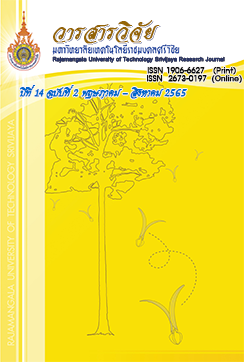การใช้ประโยชน์เศษวัสดุก่อสร้างในคอนกรีตบล็อกไม่รับน้ำหนัก
คำสำคัญ:
คอนกรีตบล็อกชนิดไม่รับน้ำหนัก, วัสดุผสม, เศษวัสดุก่อสร้าง, กำลังต้านทานแรงอัดบทคัดย่อ
งานวิจัยนี้มีวัตถุประสงค์นำเศษวัสดุก่อสร้างมาผลิตคอนกรีตบล็อกไม่รับน้ำหนัก โดยใช้เศษคอนกรีตแทนที่ทราย และเศษกระเบื้องเซรามิคแทนที่หินฝุ่น ในอัตราส่วนร้อยละ 0, 25, 50, 75 และ 100 โดยน้ำหนัก อัตราส่วนปูนซีเมนต์ต่อมวลรวมเท่ากับ 1:5 ทดสอบคุณสมบัติคอนกรีตบล็อกเปรียบเทียบกับมาตรฐาน มผช.779/2548 และ มอก.58/2533 ผลการศึกษาพบว่าค่าความถ่วงจำเพาะ (ถ.พ.) เศษคอนกรีตมีค่าต่ำกว่าทราย และเศษกระเบื้องเซรามิคมีค่าต่ำกว่าหินฝุ่น พิจารณาคุณสมบัติของคอนกรีตบล็อกพบว่าเมื่ออัตราส่วนการแทนที่เพิ่มขึ้นทำให้หน่วยน้ำหนักของคอนกรีตบล็อกลดลง และความสามารถในการดูดซึมน้ำเพิ่มขึ้น ในด้านค่ากำลังต้านทานแรงอัดพบว่าคอนกรีตบล็อกที่อัตราส่วนร้อยละ 50 มีความเหมาะสมที่สุดโดยผ่านเกณฑ์มาตรฐาน มผช.779-2548 และ มอก.58-2533 ที่อายุ 28 วัน มีค่าเท่ากับ 2.53 เมกะพาสคาล
เอกสารอ้างอิง
Al-Bukhaiti, K.M., Hassan, M., Hamzah, A., Zaidi, K. and Ali, A. 2018. Study the Recycling and Use of Construction Waste in Concrete Mixtures in Yemen. International Journal of Scientific & Engineering Research 9(3): 1152-1154.
Amnuaypornlert, S. 2017. A Study of Property Compressive Strength and Bending Strength of Concrete Mixed with Ceramic Fragments. Kasalongkham Research Journal 11(3): 279-291. (in Thai)
ASTM. 2001a. ASTM C128. Standard Test Method for Specific Gravity and Absorption of Fine Aggregate. Annual Book of ASTM Standards, American Society for Testing and Materials, Vol. 04.02, Philadelphia.
ASTM. 2001b. ASTM C29. Standard Test Method for Unit Weight and Voids in Aggregates. Annual Book of ASTM Standards, American Society for Testing and Materials, Vol. 04.02, Philadelphia.
ASTM. 2001c. ASTM C136. Standard Test Method for Sieve Analysis of Fine and Coarse Aggregates. Annual Book of ASTM Standards, American Society for Testing and Materials, Vol. 04.02, Philadelphia.
ASTM. 2005. ASTM C203. Standard Specification for Flow Table for Use in Test of Hydraulic Cement. Annual Book of ASTM Standards, American Society for Testing and Materials, Vol. 04.01, Philadelphia.
ASTM. 2011a. ASTM C138. Standard Test Method for Density (“Unit Weight”), Yield, and Air Content (Gravimetric) of Concrete. Annual Book of ASTM Standards, American Society for Testing and Materials, Vol. 04.02, Philadelphia.
ASTM. 2011b. ASTM C33. Standard Specification for Concrete Aggregates. Annual Book of ASTM Standards, American Society for Testing and Materials, Vol. 04.02, Philadelphia.
Boonseela, M., Kheefah, P., Butakhian, P., Geunram, R. and Ritdej, S. 2019. The Recycle Demolished Concrete from Community Construction Sites to be used as Processed Concrete Sheets for Pavement. Journal of Industrial Technology Buriram Rajabhat University 9(2): 82-90. (in Thai)
Chindaprasirt, P. and Jaturapitakkul, C. 2013. Cement Pozzolan and Concrete. 7th ed. Thai Concrete Association, Bangkok. (in Thai)
Choosakul, C. 2016. Concrete Technology Theory and Practice. Triple Group Co.,Ltd., Bangkok. (in Thai)
Environment Department. 2014. Provide construction waste disposal services Open for free. Available Source: http://203.155.220.174/modules.php?name=activeshow_mod&file=article& asid=685, November 6, 2014. (in Thai)
Higashiyama, H., Yagishita, F., Sano, M. and Takahashi, O. 2012. Compressive Strength and Resistance to Chloride Penetration of Mortar using Ceramic Waste as Fine Aggregate. Construction and Building Materials (26): 96-101.
Khamput, P. 2017. Hollow Non-Load-Bearing Concrete Block Products from Fragments of Ceramic Tiles, pp. 79-84. In Proceedings of the 22nd National Convention on Civil Engineering. Rajamangala University of Technology Isan, Suranaree University of Technology, The Engineering Institute of Thailand Under H.M. The king's Patronge, Nakhon Ratchasima. (in Thai)
Khamput, P. 2018. Research Report on Hollow Non-Load-Bearing Concrete Block Products from Fragments of Ceramic Tiles for Small and Medium Enterprises. Rajamangala University of Technology Thanyaburi. (in Thai)
Rattanachu, P., Premruetha, K., Tangchirapat, W. and Jaturapitakkul, C. 2015. Effects of Ground Fly Ash on Compressive Strength and Durability of Recycled Aggregate Concretes. Princess of Naradhiwas University Journal 7(1): 92-105. (in Thai)
Senthamarai, R.M. and Manoharan, P.D. 2005. Concrete with ceramic waste aggregate. Cement & Concrete Composites 27(9-10): 910-913.
Sukontasukkul, P. 2013. Concrete. 2nd ed. Wankawee Publishing, Pathumthani. (in Thai)
TCPS. 2005. TCPS. 779-2005. Thai Industrial Standards Institute, Community Production Standards for Hollow Block Non-Load-Bearing. Ministry of Industry, Bangkok. (in Thai)
TIS. 1974. TIS. 109-1974. Thai Industrial Standards Institute, Standard for Sampling and Testing Concrete Masonry Unit. Ministry of Industry, Bangkok. (in Thai)
TIS. 1990. TIS. 58-1990. Thai Industrial Standards Institute, Standards for Hollow Non-Load-Bearing Concrete Masonry Unit. Ministry of Industry, Bangkok. (in Thai)
TIS. 2004. TIS. 15-2004. Thai Industrial Standards Institute, Portland Part 1 Specification. Ministry of Industry, Bangkok. (in Thai)
Treepong, K. and Thepwong, R. 2020. A Study of Water Permeability on Porous Concrete Using Recycle Coarse Aggregates, pp. MAT13-1-MAT13-7. In Proceedings of the 25th National Convention on Civil Engineering. The Engineering Institute of Thailand Under H.M. The king's Patronge, Burapha University, Rambhai Barni Rajabhat University, Kasetsart University, Chonburi. (in Thai)
United State Environment Protection Agency [USEPA]. 2017. Waste Minimization Opportunity Assessment Manual. USEPA, Ohio.
Wagih, A.M., El-Karmoty, H.Z., Ebid, M. and Okba, S.H. 2013. Recycled construction and demolition concrete waste as aggregate for structural concrete. Housing and Building National Research Center Journal 9(3): 193-200.
Wongsa-nga, S. and Sathonsaowaphak, A. 2018. Optimum Usage of Recycle Concrete with Different Particle Size for Compressive Strength of Mortar Plastering. Srinakharinwirot University (Journal of Science and Technology) 10(19): 136-143. (in Thai)
ดาวน์โหลด
เผยแพร่แล้ว
รูปแบบการอ้างอิง
ฉบับ
ประเภทบทความ
สัญญาอนุญาต
ลิขสิทธิ์ (c) 2022 วารสารวิจัย มหาวิทยาลัยเทคโนโลยีราชมงคลศรีวิชัย

อนุญาตภายใต้เงื่อนไข Creative Commons Attribution-NonCommercial-NoDerivatives 4.0 International License.
เนื้อหาและข้อมูลในบทความที่ลงตีพิมพ์ในวารสารวิจัยมหาวิทยาลัยเทคโนโลยีราชมงคลศรีวิชัย ถือเป็นข้อคิดเห็นและความรับผิดชอบของผู้เขียนบทความโดยตรง ซึ่งกองบรรณาธิการวารสารไม่จำเป็น ต้องเห็นด้วย หรือร่วมรับผิดชอบใดๆ
บทความ ข้อมูล เนื้อหา รูปภาพฯลฯ ที่ได้รับการตีพิมพ์ในวารสารวิจัย มหาวิทยาลัยเทคโนโลยีราชมงคลศรีวิชัย ถือเป็นลิขสิทธ์ของวารสารวิจัย มหาวิทยาลัยเทคโนโลยีราชมงคลศรีวิชัย หากบุคคลหรือหน่วยงานใดต้องการนำทั้งหมดหรือส่วนหนึ่งส่วนใดไปเผยแพร่ต่อหรือเพื่อการกระทำการใดๆจะต้องได้รับอนุญาตเป็นลายลักษ์อักษรจากวารสาร มหาวิทยาลัยเทคโนโลยีราชมงคลศรีวิชัยก่อนเท่านั้น







